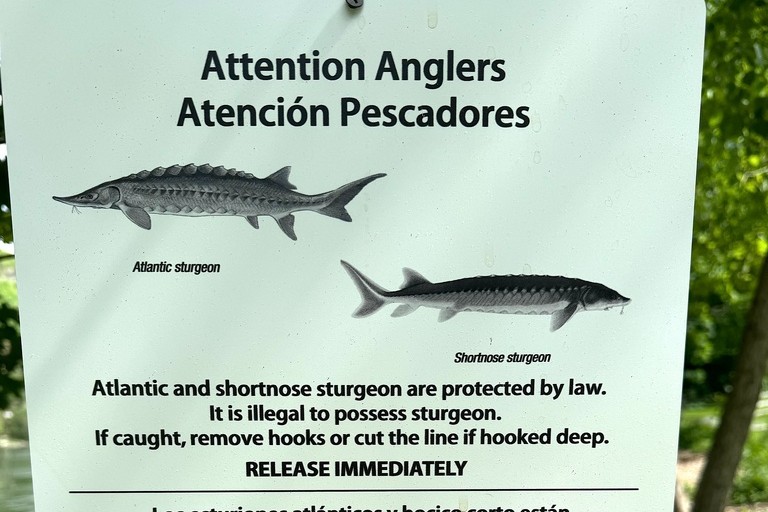This story by Robert F. Smith was first published in The Commons on June 12.
BELLOWS FALLS — It has taken two years since researchers first began accumulating evidence, but on June 7, scientists announced that shortnose sturgeon are living in the Connecticut River as far north as the hydroelectric dam in Bellows Falls.
Sturgeon exist in the fossil record going back 250 million years and, for thousands of years, have been native species in the Connecticut River.
But this is the first time that sturgeon, which can grow up to 4.5 feet in length and live for up to 30 years, have been verified to exist in this portion of the Connecticut River since 1907. Since 2018, sturgeon had been verified only as far north as the Vernon dam.
Among the data that scientists discussed and presented at the June 7 meeting at the Conte Laboratory were fishway count data on fish ladder inspections at the dams on the river and assessment reports on various species in the Connecticut River, including various fishes, American eel, and sea lamprey.
Involved in the study were Micah Kieffer, a research fishery biologist since 1991, who specializes in sturgeon at the U.S. Geological Survey’s Silvio O. Conte Research Laboratory in Turners Falls, Massachusetts; Kate Buckman, the Connecticut River Conservancy’s New Hampshire River Steward, who has a bachelor’s degree in biological science from Smith College and a Ph.D. in oceanography from MIT; James Garner, a doctoral student at the University of Massachusetts and an environmental DNA specialist; and master scuba diver Annette Spaulding, who for over two decades has averaged 117 dives a year in the Connecticut River.
Kieffer’s presentation included a video from New Hampshire angler Patrick Dupell, taken during the July 2023 Connecticut River flood. Kieffer reviewed the film in depth and concluded that it showed sturgeon in a flooded cornfield in Walpole, N.H., as far as a mile inland from the main river bed.
Scientists have said that it is not unusual for sturgeon, during heavy flooding, to wander away from a main river into more shallow and protected flood waters.
Most convincing was a video taken in 2022 by a University of Vermont student which shows sturgeon surfacing in Bellows Falls just below the hydro station at the Historical Society’s Riverfront Park.
When the student found out about the sturgeon research in March of this year, he brought his video to the attention of the scientists.
Kieffer said that the video has now been verified. It was taken below the hydroelectric generator run-out in Bellows Falls and shows two sturgeon at the surface of the river, one of them in unmistakable clarity.
The National Oceanic and Atmospheric Administration, a division of the U.S Department of Commerce, published “Recovery Plan for the Shortnose Sturgeon” in December 1998.
That plan is still in effect, and lays out the operating requirements for dams in the Connecticut River watershed in order to maintain a viable spawning and survival environment for the sturgeon.
NOAA has begun placing Atlantic and shortnose sturgeon information signs at popular river access sites, the first of which were installed at Riverfront Park in Bellows Falls. These show anglers how to identify sturgeon, and provide information on how to return them to the river if they are inadvertently caught.
Sturgeon are protected by law and possession of sturgeon is illegal. However, to aid in the study of this ancient species, anglers and boaters are encouraged to video, photograph, and report sightings of live, injured, or dead sturgeon to the Upper Connecticut River Sturgeon Research Collaboration at 413-863-3817 or mkieffer@usgs.gov; or 413-863-3802 or btowler@usgs.gov.
The input of anglers in this study is vital, Kieffer said. Anglers can often provide the most vital details needed about this species.
The watershed’s hydroelectric dams can affect the sturgeon, the study says, by restricting their habitat, altering river flows and water temperatures, and causing fish deaths in plants’ turbines.
At most of the dam sites in the watershed, the spawning sturgeon were located just below the dams, making them particularly vulnerable to plant operations.
The NOAA sturgeon recovery plan states, “As spawning timing and locations are identified in these regulated rivers, flows that create acceptable spawning conditions should be maintained during the spawning period. Thus, the operating plans for hydroelectric generating facilities and flood storage reservoirs should include special conditions to protect shortnose sturgeon.”
Because of these regulations, the verification of shortnose sturgeon in the river as far north as Bellows Falls is likely to continue to be a factor in the current process of renewing generating licenses for hydroelectric facilities on the river.
Three hydroelectric dams and generating stations that are located on the Connecticut River in Wilder, Bellows Falls, and Vernon, plus two in Massachusetts, control the flow of the river over 126 miles.
The dams have been in the process of renewing their operating licenses since 2012 – a process that was extended for public comment by the Federal Energy Regulatory Commission until May 22.
The facilities were last licensed by FERC over 40 years ago, and the five facilities had their licenses expire in April 2018. Renewed licenses are expected to be for a period of up to 40 years.
The Wilder, Bellows Falls, and Vernon dams are owned by Great River Hydro, formerly known as TransCanada. The company was sold to Hydro-Quebec in February 2023. Hydro-Quebec is a corporation owned by the government of Quebec.
The two Massachusetts hydro facilities, the Turners Falls Dam and Northfield Mountain Pump Storage Project, are limited liability companies owned by PSP Investments under FirstLight Power Services LLC. PSP is also a Canadian company.
Read the story on VTDigger here: After more than a century, sturgeon return to Bellows Falls.

